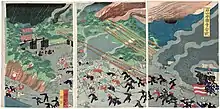Ishiyama Hongan-ji War
The Ishiyama Hongan-ji War (石山合戦, Ishiyama Kassen), taking place from 1570 to 1580 in Sengoku period Japan, was a ten-year campaign by lord Oda Nobunaga against a network of fortifications, temples, and communities belonging to the Ikkō-ikki, a powerful faction of Jōdo Shinshū Buddhist monks and peasants opposed to the rule of the samurai class. It centered on attempts to take down the Ikki's central base, the cathedral fortress of Ishiyama Hongan-ji, in what is today the city of Osaka. While Nobunaga and his allies led attacks on Ikki communities and fortifications in the nearby provinces, weakening the Hongan-ji's support structure, elements of his army remained camped outside the Hongan-ji, blocking supplies to the fortress and serving as scouts.
| Siege of Ishiyama Hongan-ji | |||||||
|---|---|---|---|---|---|---|---|
| Part of the Sengoku period | |||||||
 The battle of Ishiyama Hongan-ji by Utagawa Yoshifuji (1828-1887) | |||||||
| |||||||
| Belligerents | |||||||
| forces of Oda Nobunaga |
Ikkō-ikki monks Mōri clan forces of Ashikaga Yoshiaki[1] | ||||||
| Commanders and leaders | |||||||
|
Oda Nobunaga Niwa Nagahide Hosokawa Fujitaka Sakuma Nobumori Akechi Mitsuhide Harada Naomasa Araki Murashige Takayama Ukon Andō Morinari |
Kōsa Saika Ikki Shimozuma Nakayuki Murakami Motoyoshi | ||||||
| Strength | |||||||
| at least 30,000 | at least 15,000 | ||||||
Background
The Ikkō-ikki leagues of warrior monks and commoners were among the last to stand in the way of Oda Nobunaga's bid to conquer all of Japan. Oda and Tokugawa had fought the Ikki before, crushing their armies of Mikawa Province and other areas, and by 1570, their twin fortresses of Ishiyama Hongan-ji and Nagashima were their last bastions of strength. He besieged both fortresses simultaneously, attacking Ishiyama in August 1570 and Nagashima in 1571.
Siege
In August 1570, Oda Nobunaga left Gifu Castle in Gifu with 30,000 troops, and ordered his generals to build fortresses around Ishiyama, while Nobunaga himself focused on the Sieges of Nagashima fortress and other campaigns. On September 12, the Ikkō-ikki launched a midnight stealth attack against Nobunaga's forces at Kawaguchi and Takadono. The Ikko were reinforced by soldier monks from Negoro-ji in Kii Province and 3,000 musketeers, pushing Oda's army back.[2][3][4] Nobunaga's armies remained camped out, assigned to monitor the Ikki's fortress, and take it if they could.
In 1574, after destroying the Nagashima complex and reducing the threat from the Ikki's supporters, Oda attempted to starve out the fortress. This was no easy task, however, because the Ishiyama fortress sat on the coast, which was guarded by the fleet of the Mōri clan, masters of naval combat and Oda's enemies.
By early 1575, however, the fortress was already in urgent need of supplies, and the Abbot Kōsa was ready to begin peaceful overtures with Nobunaga to end the siege. But the ousted shōgun Ashikaga Yoshiaki sent a letter to Mōri Terumoto asking for his aid in supplying the cathedral fortress.[4]:288–289 Yoshiaki eventually raised some troops himself to aid the besieged.[1]
In April 1576, Oda's army attacked Hongan-ji with 3,000 men under Harada Naomasa, Akechi Mitsuhide and Araki Murashige, but Oda forces were quickly repelled by 15,000 defenders.[3] After Harada Naomasa's death during the campaign, Sakuma Nobumori was chosen as Harada's replacement as part commander of the Siege of Ishiyama Hongan-ji and given troops from seven provinces placing him in command of the largest Oda-clan army among the Oda retainers. By then, 51 outposts had been built around the central fortress, many equipped with arquebus squads. However, Nobumori made no progress againts the Hongan-ji and in the mean time Kuki Yoshitaka failed to blockade Mōri supply lines in the first Battle of Kizugawaguchi.
In 1577, Oda Nobunaga was forced to revise his tactics and began to attack the outposts, and the supporters of the Ikki.[4]:289 Nobunaga sent Toyotomi Hideyoshi to lead an assault on Saika Ikki, the monk's fortress at Negoro-ji[3] and accused Araki Murashige cause of sympathies to the Mōri clan.
In 1578, Nobunaga enlisted Kuki Yoshitaka to set up a blockade and disrupt the fortress' supply lines from Mōri with massive new battleships, and in the Second Battle of Kizugawaguchi, as results Kuki Yoshitaka broke the Mōri supply lines for good.[3] he also give orders Hideyoshi to besieged Miki castle.
However in 1580, The Mori clan lost their strategic castle at Miki. By then, the siege was beginning to swing in Nobunaga's favor. The majority of the Ikki's allies were already inside the fortress with them, so they had no one to call on for aid. The Ikki under the leadership of Shimozuma Nakayuki, eventually the defenders were nearly out of ammunition and food, the Abbot Kōsa held a conference with his colleagues after receiving a letter of Advice via Imperial Messenger in April. Kōsa's son surrendered a few weeks later. The fighting finally ended in August 1580.[3]:229[4]:290
Aftermath
Nobunaga spared the lives of many of the defenders, including Shimozuma Nakayuki, but burned the fortress to the ground. In the same year, Nobunaga accused Sakuma Nobumori and dismissed Ando Morinari from Nobunaga's service following the fall of the Honganji. Three years later, Toyotomi Hideyoshi would begin construction on the same site, building Osaka Castle, a replica of which was constructed in the 20th century.
References
- Berry, Mary Elizabeth (1982). Hideyoshi. Cambridge: Harvard UP. p. 63. ISBN 9780674390256.
- Turnbull, Stephen (2003). Japanese Warrior Monks AD 949–1603. Oxford: Osprey Publishing Ltd. pp. 23–24. ISBN 9781841765730.
- Turnbull, Stephen (2000). The Samurai Sourcebook. London: Cassell & C0. p. 220,227–228. ISBN 1854095234.
- Sansom, George (1961). A History of Japan 1334–1615. Stanford: Stanford University Press. pp. 283–284. ISBN 0804705259.